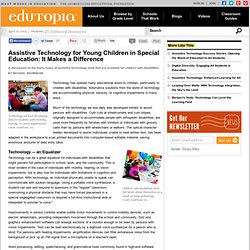

Types of Assistive Technology Products. Assistive technology products are designed to provide additional accessibility to individuals who have physical or cognitive difficulties, impairments, and disabilities.

When selecting assistive technology products, it is crucial to find products that are compatible with the computer operating system and programs on the particular computer being used. Below are descriptions of the various types of assistive technology products that are currently available on the market today. You may also want to use a tool to identify the right type of assistive technology that might be useful.
Alternative input devices allow individuals to control their computers through means other than a standard keyboard or pointing device. Examples include: Alternative keyboards—featuring larger- or smaller-than-standard keys or keyboards, alternative key configurations, and keyboards for use with one hand. Braille embossers transfer computer generated text into embossed Braille output. Education technology. MT_AssistiveTechGuide_378K. Special Education Tools for the Apple iPhone and iPad - Associated Content from Yahoo! - associatedcontent.com.
A growing educational field of interest is that of assistive technology. Through assistive technology, people with disabilities are able to bridge the gap between what they want to do and what they are physically and mentally capable of doing. Adaptive technology is by no means a new field of study, but recent tools such as the iPhone, iPad, and iPod Touch have made powerful and meaningful assistive technologies a reality for many people. Because of the range of IOS devices and the tools available at the Apple iTunes store, special education students and special education teachers are able to leverage new and exciting technologies in both exciting and economical ways. For many, the iPod Touch, iPhone and iPad are opening doors. Apple has realized this, and they have recently highlighted the growing category of IOS applications focused on special education in the Apple iTunes Store. As a general educator who is married to a special education teacher, this is of particular interest.
Assistive Technology for Special-Education Students. Assistive Technology. Implementing Assistive Technology in the Classroom: Discovery, Planning and Assessment. A Guide To Assistive Technologies. When defined, assistive technology includes any piece of equipment or device that helps to increase the independence of a disabled person.

While assistive technology is not new, it is an ever changing and growing type of technology. The distinction between assistive technologies for disabled people and adaptive technologies for the nondisabled are blurred at times. Some assistive technology inventions have been proven to be ergonomically sound and therefore they have been incoporated as standard features for the disabled and nondisabled. An example of one of those features would be the on/off switch on a keyboard which was originally developed so that disabled people did not have to reach the back of the machine. Assistive technology has helped to enormously increase the ability of disabled people to lead more independent lives. Welcome to AbleData.
Assistive Technology to Meet K–12 Needs. Weight Loss, Health and Fitness Articles. Types of Assistive Technology . Assistive Technology . Inclusive Communities . PBS Parents. The following are some examples of different types of assistive technology devices: Access and Environmental Controls: Devices that allow increased control of the environment or that open up access to things in the environment.

This includes electronic controls like switches, special keyboards or mice, and remote controls as well as things that help people get around the community, like ramps, automatic door openers, and Braille signs. Aids to Daily Living: Special tools for daily activities, like brushing teeth, dressing or eating. Assistive Listening: Supports that help a student who is either deaf or has a hearing loss. Augmentative/Alternative Communication: Supports that allow a child who cannot speak, or whose speech is not understood by others, to communicate. Computer-Based Instruction: Software to help students with learning difficulties in reading, writing, math and other subject areas. Alliance for technology access. What is assistive technology? ATTO: Assistive Technology Training Online. Types of Assistive Technology Products. Family Guide to Assistive Technology.
Family Guide to Assistive Technology Prepared By: Parents, Let's Unite for Kids (PLUK) in cooperation with The Federation for Children with Special Needs EDITOR: Katharin A. PRODUCTION: Roger Holt, ATP ILLUSTRATION: Karen Moses © Parents, Let's Unite for Kids 1997 This guide was funded through a subcontract between the Federation and Parents, Let's Unite for Kids from monies awarded to the Federation by the Office of Special Education and Rehabilitation Services (OSERS), U.S. Assistive Technology Devices for the Disabled. Assistive Technology for Young Children in Special Education: It Makes a Difference. A discussion on the many types of assistive technology tools that are available for children with disabilities.

Technology can level the playing field for students with mobility, hearing, or vision impairments. Credit: IntelliTools, Inc. Technology has opened many educational doors to children, particularly to children with disabilities. Alternative solutions from the world of technology are accommodating physical, sensory, or cognitive impairments in many ways. Much of the technology we see daily was developed initially to assist persons with disabilities. Children with disabilities often feel better about themselves as a result of using technology. Technology -- an Equalizer Technology can be a great equalizer for individuals with disabilities that might prevent full participation in school, work, and the community.